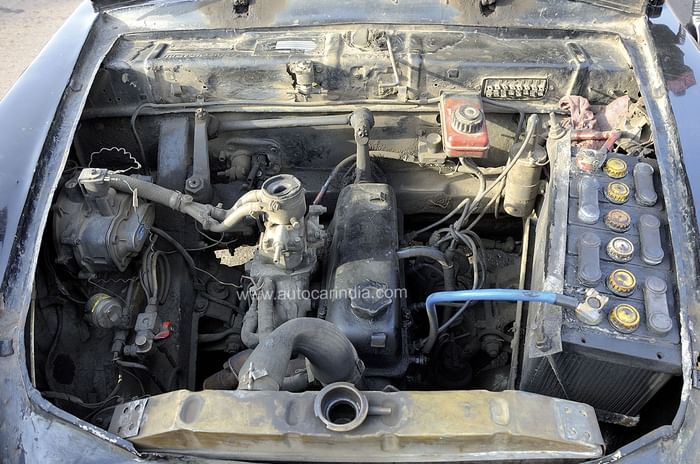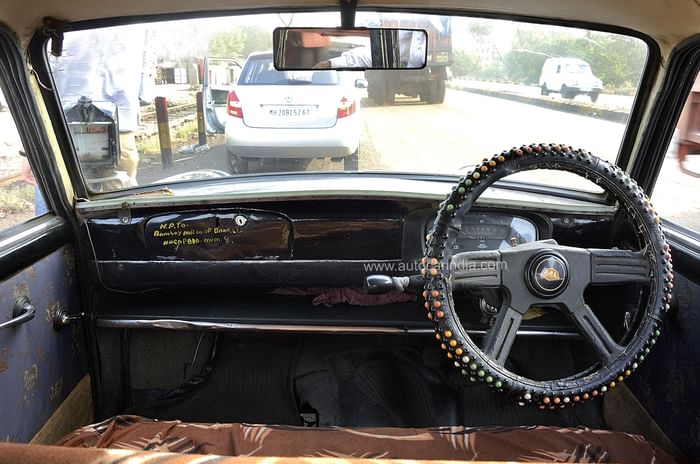Think Bombay and the first image that pops up is that of Victorian buildings, red double-decker buses, and a compact Italian sedan from the ‘50s painted in yellow and black. The taxi, of course, is the Fiat 1100 D. A well-rounded family car in its time, later sold here as the Premier Padmini, it was enjoyable to drive in the right conditions, compact in dimension and reasonably practical.
This is probably why it made for such a successful taxi – first with a petrol engine, then a diesel, and finally running on CNG. Produced all the way from 1964 to 2001 (due to the licence raj), it was a car preferred by those who drove themselves and was only outlived by its compatriot, the even longer-running Hindustan Ambassador.
 CNG feeder pipe to the carburettor and loose electric wires live in perfect harmony, radiator cap removed to reduce pressure.
CNG feeder pipe to the carburettor and loose electric wires live in perfect harmony, radiator cap removed to reduce pressure. Truth be told, it shouldn’t have been very successful as a taxi. It wasn’t as spacious or as comfortable as an HM Ambassador; it couldn’t carry as much luggage; and it didn’t ride quite as well either. Taxi drivers, however, loved it. It was ‘zippy’, compact, and agile and would make most gaps in traffic easily. What really set it apart, especially later in its extended life, was that it cost almost nothing to fix.
While the Fiat 1100 was pretty accomplished in its time and reasonably comfortable to ride in, the taxi fleet got tattier and rattier as the years went by. Soon, most were upwards of 20 years old, and that’s when we at Autocar India decided to drive one.

But why test a 20-or-so-year-old taxi? The need to test the car came about from an argument with one of Mumbai’s finest practitioners of the art of ‘restrained aggression’ – a cab driver. He had tried his best to rear-end me as I stopped for a traffic signal and, to put it mildly, we exchanged a few words. “When have you last driven one of these?” he’d queried, pointing to his bedraggled Padmini. So, in the name of science, humanity and rank stupidity, we got ourselves behind the wheel of an old cab, testing equipment in hand.
Testing Mumbai’s iconic Premier Padmini kaali peeli
Having owned and driven three Fiat 1100s in the past, I thought I would be familiar with the car. Hah, what arrogance! Nothing, not even several taxi rides, with blown tyres, free-floating rear seats or severe alignment problems could have adequately prepared me. It’s no small exaggeration to state that none of the mechanical bits functioned as they should have. None. Okay, maybe the horn worked perfectly, but that was about it.
Start-up is a wheezy crrrrr, crrrr, crrr; hopeless, almost no sign of life. Finally, it starts. Then comes the difficult job of selecting first gear. The gear slots in, but only after grating severely, even with the clutch fully depressed. There was no turbo but, boy-oh-boy, is there lag. The delay can be counted in seconds.
Once the engine begins to rev, it’s maximum noise and no performance. We timed the car from 0-60kph; any more would have been too ambitious. It is slower than we even expect. So we tested it again. And it was slower still; overheating, stuttering and threatening to shut down. Tata Sumos and Mahindra Armadas back in the day were among the slowest cars we’d tested. They took between 11 and 12 seconds to do 0-60kph. This taxi took more than twice that time – 25.23sec.

What of stability, grip and braking you ask? Almost all cabs even back in the day ran an assortment of clapped-out tyres, many on their third or fourth retread. A large percentage are slicks, you regularly see others with the ply peeking through and punctures were common. Many cabs were also rotten to the core, their chassis bent and their floor pans drooping.
Once on the move, we discover there’s around 30deg of play on either side when you steer and you need to constantly correct to keep the taxi going straight. We conducted a full brake test – yes, we really were nuts. And here too the distance travelled is twice the worst braking figure we’ve ever recorded.

Though Fiat 1100s were accomplished cars in their prime, in the '60s and '70s, and performed all manner of roles well when maintained well in private hands, most Padmini taxis even over a decade ago were only fit for the junk heap. Devoid of any directional stability, and in possession of ineffective brakes, they were simply unfit for the road. No ifs, no buts. Just how badly would these cars have fared in a Global NCAP crash test? And how roadworthy or safe are some of our older taxis today? Does anyone care?































